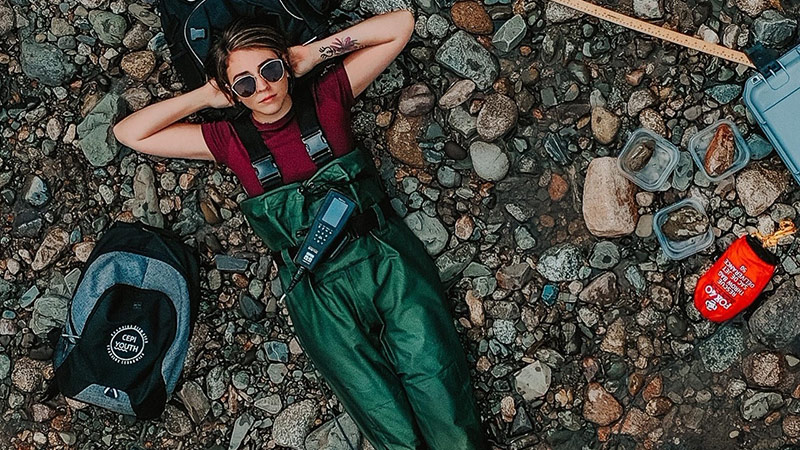Award-winning forestry student uses two-eyed seeing to enrich research on watersheds
Author: Alex Graham
Posted on Jan 12, 2024
Category: Research , UNB Fredericton

As a University of New Brunswick (UNB) forestry student, Kieran Johnson has always kept her perspective focused on the environment and the human impact on it.
That longstanding work was recognized this past November when Johnson won the Golden Award for the Collaborative Environmental Planning Initiative (CEPI) in Cape Breton. Hailing from the Eskasoni First Nation in Unama’ki (Cape Breton), Johnson’s work focuses on the watershed in that community.
“If you imagine the landscapes are like a bowl, the tops of mountains would be the rim of that bowl and all the rain that would come down into a body of water – that would make it the watershed,” she explained.
Her work focused primarily on species at risk, which encompasses not just the animals and fish that live in the watershed, but also plants and other flora.
“We did a species at risk lichen survey for blue felt lichen,” Johnson said.
In 2022, Nova Scotia designated blue felt lichen as its provincial lichen, which is the first such designation in Canada. Lichen plays an important role in sequestering carbon and are a marker for healthy habitats. Although it is found in abundance throughout the province due to its love of wet environments, the lichen is threatened by climate change and airborne pollutants.
“We were able to find it in the watershed, which is really exciting,” Johnson said.
As an estuary, where fresh inland water and salty sea water meet, the Bras d’Or Lake and river systems play an important role in the Eskasoni watershed. Johnson worked to help make one of the rivers in the system more habitable for salmon and other plant and animal life.
“The river has been widening itself and in doing so has gotten quite thin. When the water is really shallow, it heats up faster and salmon need cooler water,” she said. Using deflectors made of logs and rocks, the community is working to transform the river into a healthier environment for the salmon that call it home.
“The deflectors divert the water towards the center of the river,” Johnson explains. “They make the water deeper, create pools, and help build up the banks, creating cooler water and spots for salmon and other fish to rest in.”
“I was working on assessing the effectiveness of these deflectors and trying to encourage the salmon to come back.”
Coming from a First Nations community directly experiencing environmental changes from local, national and global effects arising from industrialization and resource extraction has given her a unique perspective on the forestry program at UNB.
“Part of what this award ceremony was for, the theme was two-eyed seeing – looking from the Western perspective but also looking from the Indigenous point of view as well, saying how can I use both of those?”
Johnson explains how Elder Albert Marshall related the concept of two-eyed seeing (Etuaptmumk) to her.
“It is taking the strengths of Indigenous knowledge and ways of knowing and the strengths of western knowledge and ways of knowing and using 'both eyes' (both perspectives) for the benefit of all.”
“It is a guiding principle and is action oriented.”
An example of this approach is the Indigenous Protected and Conserved Areas (IPCAs). Eskasoni First Nation is working to develop an IPCA around the Eskasoni watershed to protect the community’s water source as well as the land around it.
“It’s my job to look at the forestry and natural resources side of things … to start talking to the Natural Resources Committee, to our community foresters … to reach out to the elders and the people who have been on the land and say, ‘what would you like to see happen’.”
Differing definitions between the Indigenous and Western perspectives highlight the need to acknowledge and reflect on the multiple ways of understanding the environment. One definition Johnson is interested in is old growth forest.
“What I would like to do to is go through the old growth policy [in Nova Scotia] and see what is considered old growth to them, and I know that our community has also talked about what is old growth. I’d really like to compare the two and really use both to classify areas.”
Michelle Gray, the acting dean of Forestry and Environmental Management, says sustainability and connectivity are becoming increasingly important parts of the program. The faculty is making efforts to work with UNB’s Mi’kmaq-Wolastoqey Centre to attract more Indigenous students like Johnson to help bring new perspectives.
“We certainly like seeing students go out there and having an impact and making change,” Gray said of Johnson’s Golden Award win. “We’re super proud.”
For her part, Johnson is interested in using tools like IPCAs to help First Nations communities lead in natural resource management through Indigenous laws, governance and knowledge systems.
“Indigenous people have been managing it for a long time,” Johnson said of the forest and environment. “That’s what kind of comes into the theme of two-eyed seeing. How can I use both perspectives, and how can I make our world better?”
